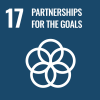
MATCHING ACTION TO AMBITION FOR TRANSFORMATIVE CHANGE
At the SDG Summit in September 2023, heads of State and government gathered to take stock of progress toward achieving the 2030 Agenda for Sustainable Development and to recommit to accelerated action to achieve its 17 Sustainable Development Goals (SDGs). The Summit, which also included a diverse array of stakeholders from civil society, academia, local governments and the private sec-tor, was convened at the halfway point between the Agenda's adoption in 2015 and its endpoint year of 2030. It shone light on two unavoidable realities: the world is dangerously off-track in its journey to achieve the SDGs and the only way to get back on course is to aggressively pursue bold, whole-of-society transformations, using systems thinking1 and a level of ambition that matches the scale of the challenges the world is facing.
Also at the Summit, an Independent Group of Scientists (IGS) appointed by the UN Secretary-General launched the 2023 Global Sustainable Development Report (GSDR), Times of Crisis, Times of Change: Science for Accelerating Trans-formations to Sustainable Development. This report synthesizes the latest science on systemic transformations, pro-viding an evidence-based tool for government officials, UN system practitioners and other partners to advance sustainable development. The GSDR aligns with many other reports showing that business-as-usual approaches to the SDGs must be replaced by truly transformative approaches. But the report goes a step further, providing details of how essential transformations can be steered in practice, through the combined efforts of diverse actors.
Crucially, progress on the SDGs requires integrated approaches that address multiple goals simultaneously, rather than narrow, sectoral approaches that focus on one or a small subset of goals. The more efficient – or even the only – way to make progress on a given target is to take advantage of positive synergies with other targets, while resolving tradeoffs.
And any transformation – no matter how big or small – moves through different phases and overcomes many barriers, before taking hold as a ‘new normal’. The GSDR breaks down the process of steering SDG enabling trans-formations – from ethical guidelines for AI to social norms around care work – through various phases. It provides evidence on what types of policies and partnerships are most likely to accelerate and stabilize positive change.
This policy brief summarizes three key recommendations from the 2023 GSDR on how to accelerate progress across all SDGs: (1) we must aim for transformation in key systems where SDGs are closely interlinked; (2) we should shape interventions deliberately according to where a country is along its trajectory of transformation; and (3) we must build capacity for cohesive, forward looking and evidence-informed action. These insights can help decision-makers match actions to ambitions in the second half of the journey toward 2030. The recommendations can also help the United Nations mobilize action and investment around the six transitions that were identified as critical pathways toward the SDGs at the SDG Summit.
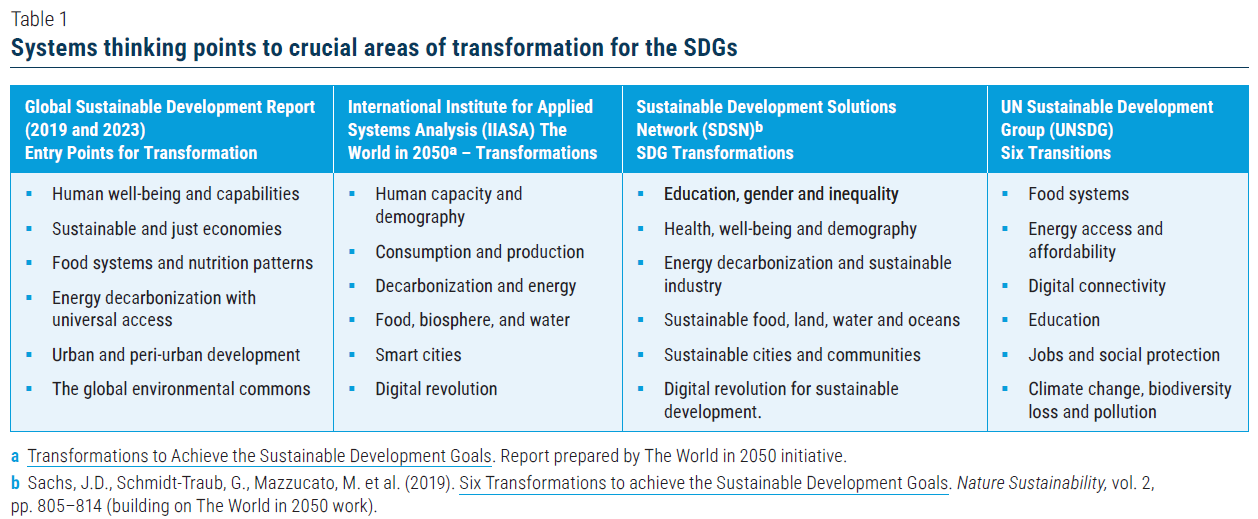
A SYSTEMS APPROACH IN KEY POLICY AREAS CAN DRIVE DURABLE CHANGE
The scientific ‘assessment of assessments’ in the GSDR concludes that sustainable development will require fundamental changes in the way we live, produce, consume, eat, move around, interact and work. These changes will be possible only through integrated actions that cut across sectors. The report finds that approaches rooted in systems thinking will allow societies to make mutually reinforcing progress in all three dimensions of sustainable development: the economic, social, and environmental.
For example, food systems, when considered holistically, are spaces where many simultaneous objectives can be achieved: from ending hunger and malnutrition, to providing decent work and a basic income, including for the mil-lions of women employed in agriculture, and eradicating poverty. Scaling up food systems as they exist now, how-ever, will only exacerbate their climate and environmental impacts, as well as harmful patterns of malnutrition and obesity.
Likewise, energy systems provide the foundation for mod-ern economic life and progress on many SDGs. Yet, the tradeoffs present in current systems of energy production are large in terms of emissions and environmental dam-age while millions remain without access to electricity. The GSDR finds that SDGs 14 (life below water) and 15 (life on land) are the most adversely affected by progress in other areas, when tradeoffs are not addressed.
The GSDR’s systems thinking approach is consistent with the work of many scholars and practitioners calling for large-scale, integrated changes in the systems that organize modern life. Various UN organizations and panels, as well as a wide range of networks and institutions including the Sustainable Development Solutions Network (SDSN), the International Institute for Applied Systems Analysis (IIASA), the Stockholm Environment Institute (SEI), South-ern Voice, Future Earth and others have offered conceptual models of these changes. The selection and framing of the systems vary, but there are common threads (see Table 1).
The UN system has identified six transitions where game-changing interventions are needed. These include: (1) food systems; (2) energy access and affordability; (3) digital connectivity; (4) education; (5) jobs and social protection; and (6) climate change, biodiversity loss and pollution. To drive these transitions, government actors at all levels are urged to work collaboratively across ministries and engage civil society and other non-government partners in an inclusive and participatory manner to identify synergies and trade-offs.
This is easier said than done, given the reality of organizational structures and budget lines, but the GSDR offers guidance on how to make it happen. For example, including more than two line ministries in national SDGs bodies has been found to strengthen horizontal coordination across different policy portfolios and ministries. In practice such coordination can generate synergies, as with Brazil’s National School Feeding Program that simultaneously sup-ports progress on food security, education, and rural development objectives. Vertical coordination, across different levels of government is also essential. At the 2023 SDG Summit, the UN itself, showcased several “High Impact Initiatives” that can serve as inspiration and guidance for others – in governments, the private sector, civil society, philanthropy – ready to make bold investments in the SDGs.
INTERVENTIONS SHOULD RESPOND TO WHERE A SYSTEM IS ALONG ITS TRANSFORMATION TRAJECTORY
Change and transformations are inevitable, but the direction and speed of change can be driven by coordinated and deliberate interventions at strategic moments. The current global conditions – marked by crisis and uncertainty – risk exacerbating poverty, inequality, hunger, disease, conflict, and disaster. But there are ample opportunities to correct course and accelerate important transformations.
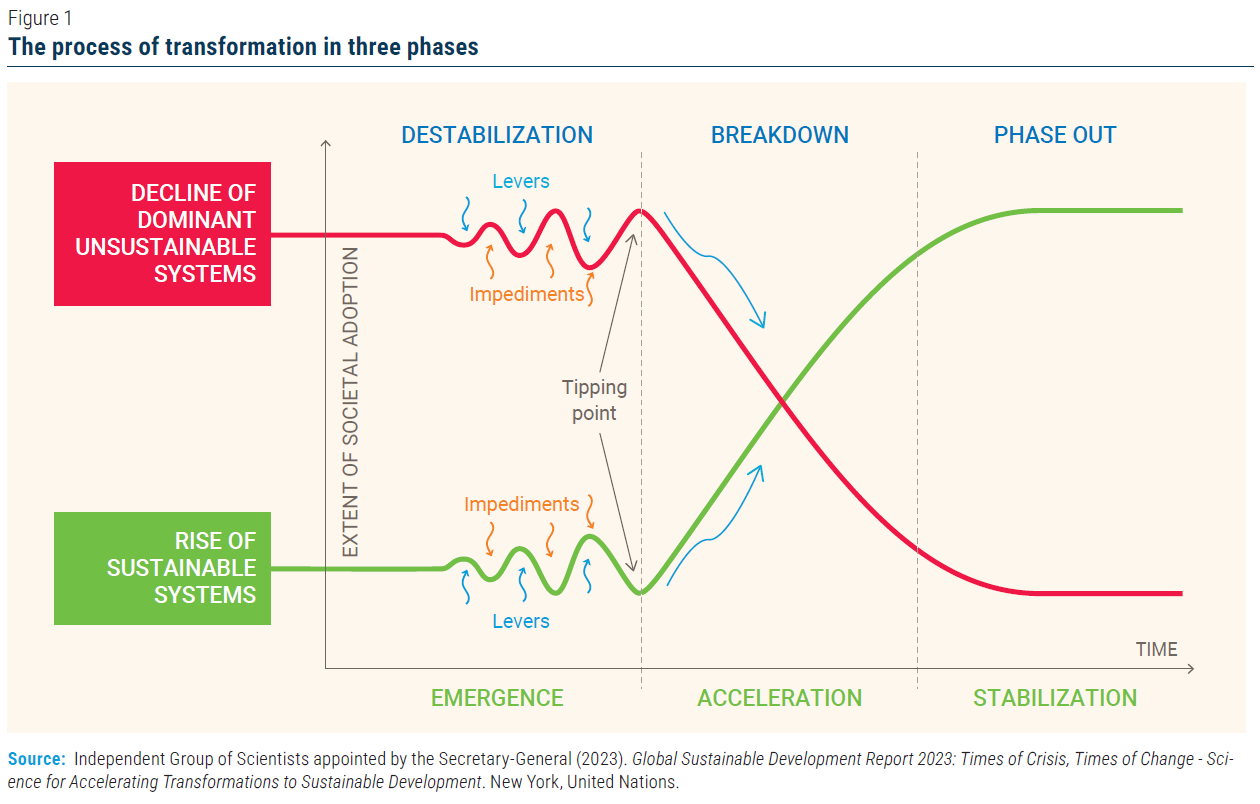
The GSDR shows how interventions and planning can drive transformations through three distinct phases – emergence, acceleration, and stabilization – that trace an s-curve (see Figure 1). These phases are relevant for trans-formations at various scales, whether encouraging changes in an individual sector as with the adoption of electric vehicles or in driving whole-of-society shifts through national planning. Policymakers can also actively encourage the decline of unsustainable systems with interventions, for example, to move energy systems away from fossil fuels and indoor air pollution from cooking.
The GSDR is filled with examples of how to tailor interventions and investments to phases of transformation, noting that countries will be at different points along the curve for a given transition. During the initial emergence (or destabilization) phase, inclusive deliberation will be important, to develop a shared vision. Governments, multilateral development banks, private finance, philanthropists, and others will need to invest in innovation and piloting, as well as in capacity building for various stakeholders. Financing for research and development and scaling up proven solutions, including community-based ones, will be key. Governments have a unique additional role in shaping regulations, incentives, policies and targets, as well as investing in infrastructure in this early phase. For example, with tax incentives for solar energy, electric vehicles, or sustainable agriculture practices.
In the acceleration (or breakdown) phase, governments will recommit to and strengthen the regulations, policies and targets initiated in the emergence phase, with investment in research and further innovation. Private sec-tor actors will need to adjust their business models, habits, and behaviors. Meanwhile government, civil society and business will need to work together to counter social and political backlash against change, as well as to over-come impediments to acceleration including subsidies to certain industries, employment and consumption pat-terns, or social norms and habits. Governments and the private sector must have the capacity to support a managed decline and phase-out of unsustainable technologies and practices—for instance, in fossil fuel related sectors. Una-voidable job losses or declines in regional industries and economies can be mitigated through government support for affected workers such as compensation, social protection, reskilling and training, and alternative employment opportunities. Momentum can be reinforced through social activism and skillfully crafted narratives—for instance, positive trends in girls’ education can be reinforced with community outreach and awareness campaigns.
In the stabilization (or phase out) phase, the innovation will saturate the market or become a new social norm, with the supporting infrastructure and policy frameworks in place. It will be important for governments and others to make sure that these frameworks are durable and resilient, able to withstand a change in elected government, economic downturns, or external crises. Ongoing capacity development will help fortify the stabilization phase, as will a steady source of financing, including from domestic taxes, private investment, and partnerships. And to ensure that no one is left behind, governments should continue investing in social protection, reskilling, and sustainable livelihoods. Long-term investments include, for instance, job training and safety net support for people employed in fossil fuel industries, unsustainable agriculture, or illicit activities like drug and wildlife trafficking.
It is perhaps easiest to recognize the S-curve shape of a transformation after the fact, when society has already passed through all three phases. An example of a completed transformation following this pattern is the rise of global infant vaccination coverage, driven by major investments by governments, international organizations, and other partners (see Figure 2 below).
Similarly monumental interventions and investments will be required in a wide range of sectors to achieve such success across the SDGs. A selection of the policy interventions that could be considered during the three phases of transformation, with adjustments to fit different contexts, are included in Table 2.
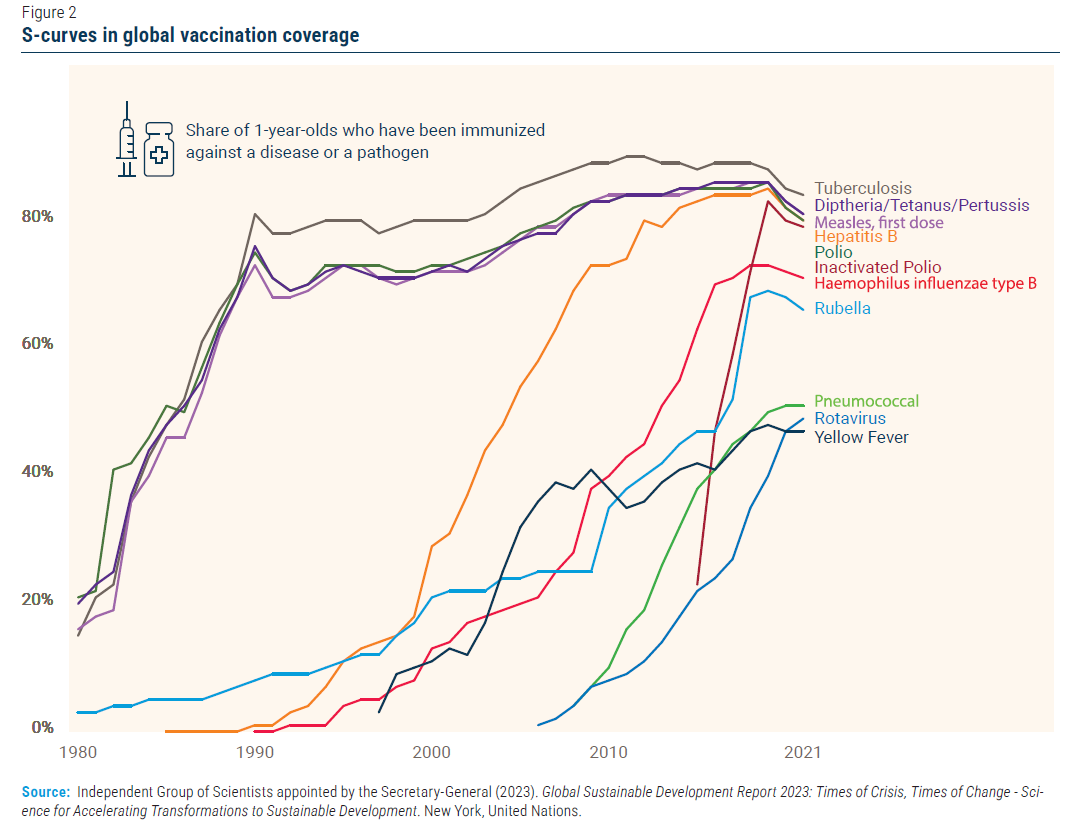
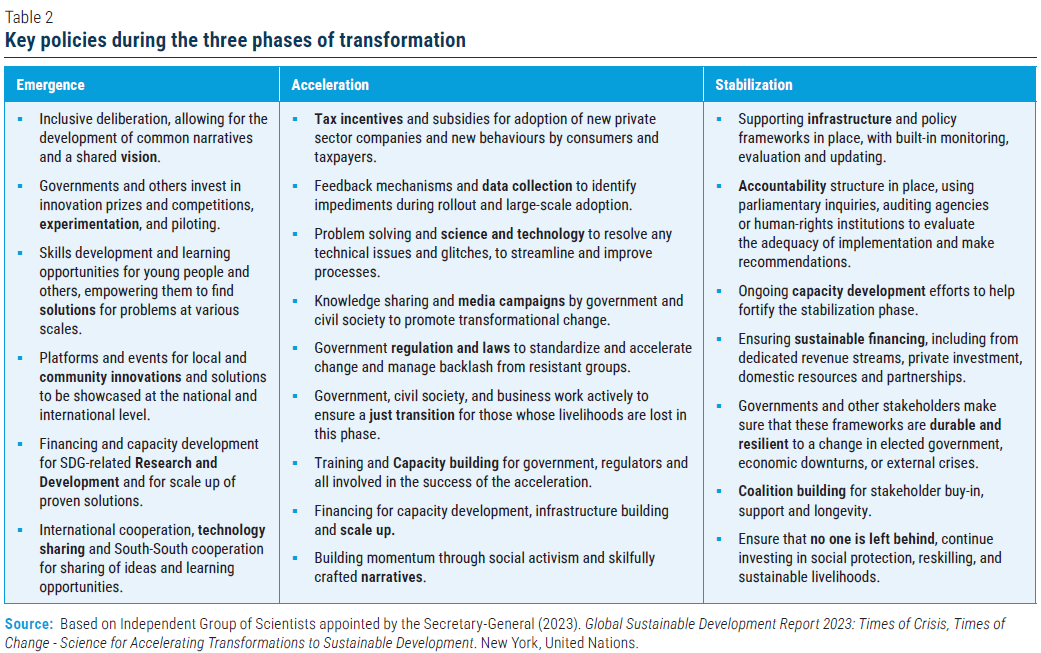
SYSTEMIC CHANGE REQUIRES NEW CAPACITIES IN ALL COUNTRIES
Systems thinking and advancing deep transformations requires new capacities for all – for governments across the world, for the UN system, for civil society actors and business leaders, for institutions, communities, households, and individuals.
Leaders will need to excel in risk management, negotiation and mediation, innovation and strategy development, and building resilience. Foresight capacity – the ability to envision a sustainable future and anticipate shocks and opportunities – will be crucial.
Government officials and policymakers will need training and support to pursue new ways of working, reaching across ministries and sectors for truly integrated policymaking. A country seeking a sustainable food system, for instance, will need to empower and bring together the agriculture, health, water, environment, land use, labor and social sectors of a government. It will also need to engage local, state or provincial, and national governments. Officials will need training on working collaboratively, both horizontally across ministries and vertically among different levels of government. They will need to work in nimble and resilient institutions to drive change.
Beyond governments, people will need new skills, spaces, and opportunities to transform society through their businesses, and through individual and community behavior, and knowledge production. Business leaders will need to learn how to manage transitions to truly sustainable pro-duction practices, supply chains, and business models. Civil society actors will need skills to engage effectively in change processes. New spaces and platforms, accessible to all including women, youth, persons with disabilities, indigenous peoples and other frequently marginalized groups, are required. Educational institutions—and new, transformed curricula, will play a key role in shaping the bold, proactive, and resilient citizenry of the future.
The UN System can support capacity building in all its forms, but it will also need to evolve – in line with the Secretary-General’s vision for a UN 2.0 and the reformed Res-ident Coordinator system. UN system staff will need to acquire and foster new skills and break down the siloes that undermine genuine transformation.
Building capacity to support rapid transformations also requires a reinvigorated science and technology ecosystem. The GSDR calls for substantial investments in science and in research for sustainable development, especially in the Global South including open science and accessible, high-quality data, and “socially robust” science that speaks to contemporary social challenges and that engages diverse stakeholders.
This kind of socially robust science, and the democratization of knowledge, can inspire people to commit to the transformations we need. Today, as we suffer from a lack of trust in institutions and in science, it will be crucial to invest in science that speaks to people and that people will believe in, and act upon.
 Welcome to the United Nations
Welcome to the United Nations

